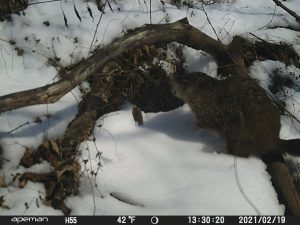by Shawndra Miller, Communications Manager
I happen to love snow. Even if I complain about shoveling and hate to drive in it, I find real magic in the kind of big snowfall we had earlier this month. Snow has a way of transforming the world into a more beautiful place. A drab and muddy slog through midwinter becomes something cozy, pretty, downright festive. (I admit that working from home increases my appreciation of this kind of weather event!)
The cold snap and snowfall also felt right: Winter should be about snow and cold, not a perennial mud-drenched thaw. With climate change shifting our seasons more every year, every “real winter” event feels like a gift.
Given my personal enjoyment of a good snow, I decided to do some research: What does snowfall mean for the natural world, besides prettying it up for human eyes? Of course, snow doesn’t bring only benefits. Large snowfalls can damage limbs and give deer access to higher branches, for example.
But let’s look at what’s good about snow. For starters, this form of H2O brings plants moisture (and is more enjoyable than cold rain, in my opinion). And snowmelt supports a year-round water supply. Several other benefits emerged in my searching:
- Snow is protective, blanketing the earth with insulation from the cold and wind. The temperature under a snowfall is higher than above it—by as much as 2 degrees F for every inch of accumulation.
- A blanket of snow cuts down on the freeze/thaw cycle that causes water in the soil to expand and contract, adding stress to plant roots.
- The subnivium, that warmed area beneath the snow’s surface, shields numerous organisms, from small burrowing mammals like shrews to even tinier microorganisms that play a vital role in the ecosystem.
- Fungi also are protected under snow. As winter progresses and snow recedes, they increase their metabolism and release nutrients from their byproducts. This process fuels spring wildflowers like those we look forward to every year in preserves like Burnett Woods.
- Nitrogen and sulfur attach to snowflakes as they fall, and when the snow melts, these and other elements support healthy plant growth.
- Snow that layers tree limbs can provide shelter to birds like the golden-crowned kinglet, a tiny but tough songbird that huddles under snow on conifer branches.*
- Snow that leaves hollows around the base of a tree offers shelter to birds like ruffed grouse.*

Truly, what we humans experience as a beautiful, peaceful snowfall (or a hassle, depending on your perspective) is so much more to the natural world. Scientists are looking into the impact of climate change on regional snowfall levels, and what that means for snow-dependent species.
Knowing all this only deepens my love of snowy weather (and my hope for more of it).
*For a fascinating list of Inuit snow-types and their wildlife benefits, see Peering into the Secret World of Life Beneath Winter Snows.
To learn the science of snow itself, including terms like “graupel” (snow pellets) and other fun snowy facts, check out the National Snow and Ice Data Center’s resources.
For a lovely meditative view of snow at Cataract Falls, enjoy this Next Indiana Campfires Slow Moments film, from Indiana Humanities and 12 Star Media.

Shawndra Miller
Communications Director